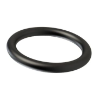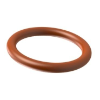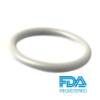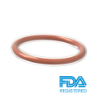Here you will find materials that you can select for your o-rings.
The o-rings can withstand different temperatures. Temperatures can vary from -40 to +340. The temperatures that the o-ring can withstand differs per material you select.
ACM
The ACM O-Rings (acrylic rubber) offers good resistance to mineral oils at high temperatures. The O ring ACM is generally used the most in the automotive industry. The water compatibility and cold flexibility of the O-ring ACM are significantly worse than with NBR.
CR
Orings from Neoprene rubbers are homopolymers of chloroprene (chlorobutadiene) and functional to the earliest synthetic rubbers used to produce seals. CR o-rings are not useful in environments with aromatic and oxygen-rich solvents. Different compositions can be used to form Neoprene for operating temperatures from -40 °C to + 110 °C.
ECO
ECO O-rings are good resistance against mineral oils, fuels, and ozone. Eco O-rings can resistance a temperature from -30°C to +150°C. The O-ring can with intermittent handle temperatures to +175°C. ECO O-rings have corrosive properties and poor compression set resistance to limit the use of ECO for sealing applications.
EPDM
O rings EPDM are the abbreviation of Ethylene, Propylene, Diene, and Monomer and are a group of synthetic rubbers or elastomers. It’s made through the polymerization of tene, propene and a diene, this is an unsaturated hydrocarbon with two double bonds.
This makes an O-rings made of EPDM a terpolymer, this is a polymer obtained from three monomers.
The ratio between the amounts of the different monomers used largely determines the properties of the EPDM polymer. The ethylene content can vary from around 45 % to 80 %. Lower ethylene levels yield a rather amorphous polymer; higher ethylene levels a more crystalline polymer. The diene content can range from approximately 1 to 10 / 12 %. With higher diene content, a higher degree of vulcanization can be obtained, which means a "firmer" rubber.
FEP
PTFE and FEP Encapsulated O-Rings are comparable in their material properties. The main difference between an O ring from PTFE and FEP is mainly in the maximum use temperature and color. PTFE is milky/white and FEP is transparent. An O-ring FEP is a slightly more favorably priced polymer compared to PFA O-rings and contains very similar PTFE and PFA properties in terms of chemical resistance, non-stick and dielectric properties. FEP is completely unaffected by UV light and has a UV transmission of more than 97%, making an Oring from FEP an ideal material for applications in UV technology.
Fluorinated ethylene propylene was discovered by the chemical company Dupont and is sold under the brand name Teflon FEP. Other well-known brands are Neoflon FEP from Daikin and Dyneon FEP from 3M.
FEPM/FFPM
Perfluoroelastomers have PTFE-similar chemical and heat resistance. They combine these positive properties of an O ring from PTFE (Tetrafluoroethylene-propylene rubber) with the elastic behavior of an Oring from FKM. Due to the considerably higher price level of this material group, perfluoro elastomers are only used if other materials can no longer meet the requirements and if safety aspects justify the higher costs. The main application areas are oilfield and chemical applications.
FFKM
O-rings from FFKM are materials that can be most stressed chemically and thermally. Some O-ring types of FFKM can handle temperatures of +300 °C. The resistance of the FFKM O-ring to chemicals is almost universal and comparable to that of an Oring PTFE. The advantage of the O ring fkm is the difference that it can be used both chemically and thermally.
FKM/VITON/FPM
This fluoroelastomer is used in multiple situations where O-rings need to be resistant to high temperatures and chemical attacks. The FPM/FKM Viton® sealing rings are often used in the aerospace, the automotive and other mechanical equipment requiring maximum resistance to high temperatures and all kinds of chemicals, fluids and other media.
HNBR
HNBR (hydrogenated nitrile butadiene rubber) is obtained by fully or partially hydrogenating the double bonds in nitrile butadiene rubber with hydrogen to single bonds. In comparison with NBR O-rings, HNBR O rings have better properties in terms of oil resistance, temperature resistance, and strength. It is more resistant to ozone and aggressive substances and can be used from -40 °C to +165 °C (with peaks up to +190 °C).
NBR
An O ring from NBR is an elastomer, which is a synthetic polymer obtained by the copolymerization of acrylonitrile and 1,3-butadiene. The characteristics are partly determined by the amount of acrylonitrile in the material and this varies from 18% to 50%. As the acrylonitrile increases, resistance to petroleum base oils and hydrocarbon fuels increases, but low-temperature flexibility decreases and the rubber can become brittle.
AU/Polyurethaan
The polyurethane rubber O-rings are characterized by very high performance. The Orings from AU have very good properties such as tear and wear resistance, high gas density, and good rebound elasticity. O rings AU also have good fuel resistance and resistance to many different types of technical oils. Due to the good temperature resistance and the good flexibility at low temperatures and the good resistance to ozone and oxygen, polyurethane rubber seals (AU O-rings) have a long service life.
PTFE/TEFLON
Teflon is an ethylene polymer in which all hydrogen atoms are replaced by fluorine. The polymer has a very large length and is still one of the largest molecules. PTFE is a thermoplastic; however, it cannot be processed in a thermoplastic manner. PTFE is pressed as a powder at room temperature in a mold and then sintered in an oven.
VMQ/Silicone
Dow Corning (a collaboration between Dow Chemicals and Corning Glass Company) was the first to produce silicone rubber. A few years later in 1947 General Electric also started the production of silicone rubber. They patented their production method. VMQ O-rings are a group of elastomeric materials made from silicones, oxygen, hydrogen, and carbon. As a group, silicones have poor tensile strength, tear-resistance, and abrasion resistance. Special compounds have been developed with exceptional resistance to heat and pressure changes. High-strength compounds have also been made, but their strength is not comparable to conventional rubber.



